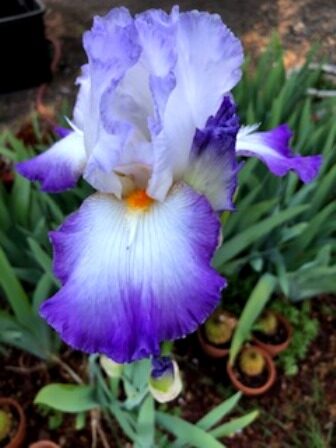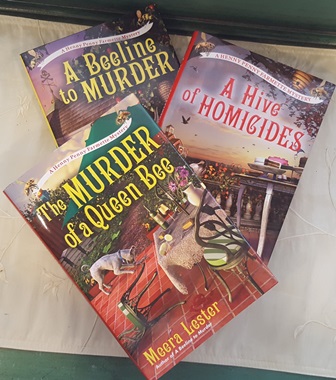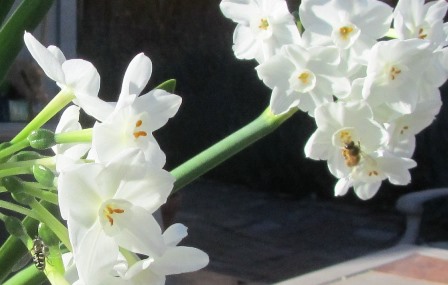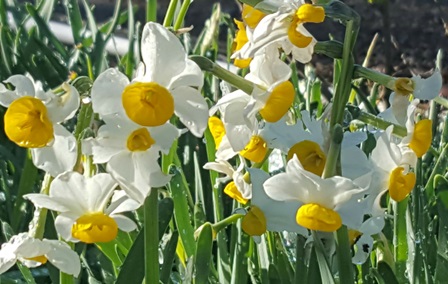The Joy of Growing Iris
Nothing beats the joy of an early morning walk in a garden and seeing iris plants in full bloom. These beauties are easy to grow, vigorous reproducers, and deer resistant.

Iris need six to eight hours of sun each day. If you live in a hot climate, your iris will need some shade protection. They perform best in well-drained soil.
The best time of the year to plant iris seems to be late summer or early fall when the temperature does not fall below 40 degrees Fahrenheit.

The rhizomes of iris tend to spread, so you’ll want to divide the clumps every three to four years. The best time to divide them is about six weeks after flowering.
To divide, dig up the clump, pull the rhizomes (roots) from the sides of the mother plant and then plant the new rhizomes, burying them so that the roots are pointing down and the top foliage (even if you have cut it back to a few inches) is exposed. Cover with soil, tamp down, and water well.
Space the iris rhizomes at least one to two feet apart. Planting too close together reduces the number of blooms. There are many varieties of iris to choose for your garden; two of the most common types are Bearded iris and Siberian iris. Plant some of these beauties and experience the joy of seeing them bloom in your garden.

If you enjoy reading about gardening and country living topics, check out my series of cozy mysteries based on my life on the “real” Henny Penny Farmette. The novels are chocked full of tips on gardening, keeping chickens and bees, and growing heirloom vegetables and fruits.

Barnesandnoble.com, and other online bookstores
My novels and self-help, spirituality, and wellness books are offered online and everywhere books are sold. Check out my author’s page on Amazon and also on Simon and Schuster.com.–Meera Lester
Critter-proofing Your Bulbs
I planted bagfuls of tulips, daffodils, crocus, and grape hyacinths over the last two years in the autumn. The daffodils are blooming now and the other bulbs in my garden have plenty of foliage.
Because voles, moles, gophers, squirrels, raccoons, and other critters will dig and eat the bulbs and deer will devour the blooms at first blush of color, a savvy gardener must figure out how to protect these beautiful flowers.

The bees are drawn to the sweet scent of narcissus that have now naturalized in my Henny Penny Farmette gardens
Throughout the Midwest of my youth, hillsides, front yards, and cemeteries were always places where daffodils grew in perfusion. Along with the arrival of robins and other songbirds, these flowering bulbs herald the coming light and warmth of spring. I’ve lost plenty of these plantings myself so have some tips to help you prevent such a loss.
Seven ways to protect flowering bulbs.
1. Grow them behind a double fence barrier. Deer can jump high and might go over one fence, but not a second one built near the first.
2. Use mesh to deter moles, voles, gophers, groundhogs, and other digging critters.
3. Erect fences that are at least three feet tall and with at least a foot buried beneath the earth.
4. Plant in raised beds covered with mesh. The bulbs will be protected while the foliage and blooms poke through toward the light.
5. Clean up the area in the fall after planting the bulbs. That way, critters won’t be attracted to your bulb beds.
6. Consider using deer-repellent sprays on tulips and growing deer-resistant bulbs.
7. Use ammonia-soaked rags in coffee cans or old planting buckets around the garden to repel pests with a keen sense of smell such as rabbits and opossums.
* * *
Enjoy reading about farming topics? Check out my cozy mysteries–A BEELINE TO MURDER and also THE MURDER OF A QUEEN BEE (both in the Henny Penny Farmette series from Kensington Publishing). Kobo Books has A BEELINE TO MURDER on sale. Check out this incredible deal on https://www.kobo.com/us/en/search?Query=Meera+Lester
My farmette and bee-based novels are chocked full of recipes, farming tips, chicken and beekeeping tips, sayings and, of course, a charming cozy mystery. For more info, click on the links under the pictures.
The books are available through online retailers such as Amazon, Barnes & Noble, Target, BAM, Kobo Books, and Walmart as well as from traditional bookstores everywhere.
See, http://tinyurl.com/hxy3s8q
A Beeline to Murder is the debut novel that launched the Henny Penny Farmette series of mysteries. Initially released as a hardcover novel and in e-book format, it is now available as a mass market paperback.
See, http://tinyurl.com/h4kou4g
NEWLY RELEASED! This, the second cozy mystery in the Henny Penny Farmette series, is garnering great reviews from readers and industry publications.
 Facebook
Facebook Goodreads
Goodreads LinkedIn
LinkedIn Meera Lester
Meera Lester Twitter
Twitter






